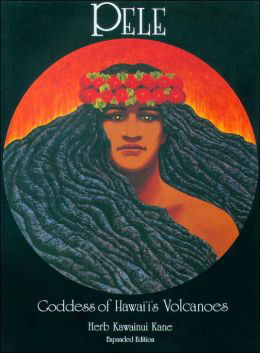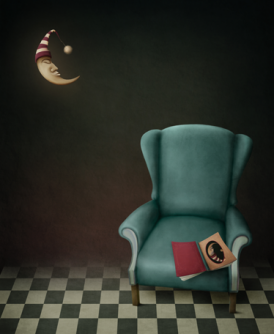Writing with Pele
Many people in Hawai’i, especially those who live near Kīlauea on the big island, experience the presence of Pele every day as they see her lava flow. As one Hawaiian said in a recent Discovery Channel documentary, “She’s the land. She made the land. I mean, it’s coming right at you. You can walk right up to it.”
Consider Pele and the Qualities of Fire
One simple way to work with an image is to reflect on it and write about it. You can write what you see in the image and everything that comes up for you when you look at it—your feelings, sensations, memories, and associations. Click here to see the image of Pele that I’ll show during my talk, a beautiful painting by artist and historian Herb Kawainui Kane.
To extend this exercise, you can explore the qualities the image embodies.
This can be a particularly productive practice when you’re working with mythic and divine images, which hold transpersonal meaning and which can evoke personal insights.
Pele is the goddess of fire, a transformational element. Fire is both destroyer and creator and, in both aspects, essential to life. Fire evokes passion, love, power, creativity. As you reflect on these qualities, you might consider the nature of fire.
Consider how fire looks, how it feels, how it smells, the way it changes from one form into another … the way it transforms itself.
Visualize different forms of fire … a candle … a bonfire … a forest fire … a volcano….
Consider the creative power of fire … the way a candle transforms your mood … how lava flow takes over the land and, in so doing, creates new land.
Consider the ways that fire interacts with air, water, and earth.
Explore your relationship to fire. How do you experience fire in your body? Where do you feel the warmth? How do you experience the heat of passion?… What role has fire played in your life? … What memorable experiences have you had with fire? What happened? Who were you with? What sensations did you experience?
Whenever you’re ready, write about fire.
Explore Pele’s Stories

Read the discussion about Herb Kawainui Kane’s book Pele: Goddess of Hawai’i’s Volcanoes at goodreads.com. View more of his art here.
There are at least two tales involving Pele’s disputes with her sisters. She is said to have come to Hawai’i from Tahiti by canoe. According to one legend, she left Tahiti because she and her sister Na-maka-o-Kaha’i, the sea goddess, were fighting. Kane says that the sea goddess followed Pele and that “whenever Pele excavated a crater with her digging stick her sister deluged it with water.” He notes that this is an apt description of the way “in which these islands were built … as the ocean floor slid northwest over a ‘hot spot’ in the underlying layer of the earth’s crust.”
In another tale, Pele sends her youngest sister Hi’iaka, goddess of the hula, to fetch Pele’s lover Lohi’au. Her sister’s journey is fraught with danger, and with each challenge Hi’iaka grows stronger. Pele is furious when she learns that Hi’iaka and Lohi’au have fallen in love. Pele kills Lohi’au and destroys Hi’iaka’s beloved ‘ohi’a trees. In the struggle between the sisters, Hi’iaka finds the strength to stand up to Pele. This tale also reflects the natural cycle of destruction and creation. The lava that wipes out the ‘ohi’a trees later creates the fertile soil from which new ‘ohi’a trees will grow.
The renowned dance company Halau O Kekuhi translated this story in a production that blends traditional Hawaiian chant and hula with contemporary theater innovations. “Holo Mai Pele” (Pele Travels) premiered on Maui in 1995 and was later presented on PBS. This beautiful video shows the introduction to the piece. (4 minutes, 34 seconds)
Retell a Myth
Author Darien Gee weaves some of the Pele myths together in a contemporary tale called “Pele in Therapy,” which is included in the anthology Don’t Look Back: Hawaiian Myths Made New. You can read an excerpt from the story here. On her website she talks about how she was inspired to write the story, and she discusses writing in Hawaii in this interview.
In my forthcoming book for women writers, I share the process I’ve used to work with mythic figures and retell myths. I love retelling old stories, turning them on their heads, following them down dark and comical plot lines to absurd and evocative encounters with mythical beings. In my story “Red Hot Peppers,” published in the Spring 2003 issue of Natural Bridge, I retell the Garden of Eden myth in the voice of Eve, who is an actress with amnesia in a desert shoot. Through the course of the movie production she realizes that she has not been a strong advocate for herself and, with the help of a powerful snake and an act of God, she discovers the power of her voice.
Here’s a basic exercise you can try with any mythic story:
- Visualize the setting where the story takes place; use your imagination to enter the scene and experience it with all your senses. Then describe what happens there.
- Ask questions of the story. For instance, if it’s about jealousy and power, ask what’s behind the jealousy; ask how the power manifests. Explore the movement of the story, how the characters change, how their fortunes may be reversed.
- Work with the natural elements at play in the story. Is this a story of earth, air, water, or fire? How do you experience these elements?
- Write a dialogue with any of the archetypal figures in the myth. Ask the figure anything you want to know; write down her answers. The results may surprise you.
- You might also want to try writing in first person, as if you are this figure. That’s what I did in my tale about Eve.
- Retell the story in your own words. Set the story in a new place and a different time.
Learn More about Pele
- Read an insightful essay, “TuTu Pele: The Living Goddess of Hawai’i’s Volcanoes,” by theologian Patricia ‘Iolana; this is the source I used for quotes from Herb Kawainui Kane in this post.
- Download a PDF of “Pele, Ancient Goddess of Contemporary Hawaii,” by H. Arlo Nimmo, in Pacific Studies, Vol. 9, No. 2-March 1986. This is a long, in-depth, scholarly article and quite interesting.
- Read a brief synopsis of the myth of Pele and her sister Hi’iaka at PBS (but note that many of the links on this page are dead).
- Listen to “The Legend of Pele: The Fire Goddess,” as told by Kamokila Campbell.
Read more of my posts on exploring the feminine.
What are you willing to fight for? How do you see the cycle of destruction and renewal manifesting in your writing process? How have these exercises worked for you?


Wonderful blog! I am really looking forward to your talk at Ghost Ranch, and cannot wait for your book! I work with myths and archetypes of the divine feminine in my own poetry, and we live on the island of Hawai’i, Pele’s home. This is sensitive, accurate, evocative — perfect!
Thanks, Ruth! I learned so much about Pele as I researched and wrote this post. Next Wednesday I’m posting “Writing with Grandmother Spider.” Recently I posted “Writing with Kwan Yin.” I couldn’t fit any of this great material into my talk, so I’ve been on a goddess blogathon. Pele is most inspiring! You are, too!